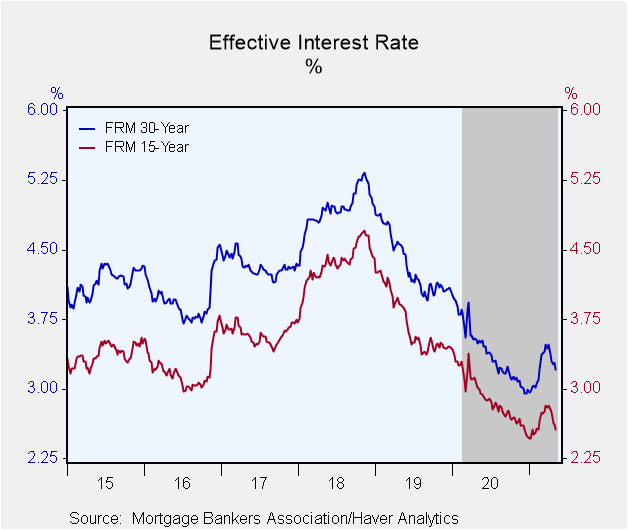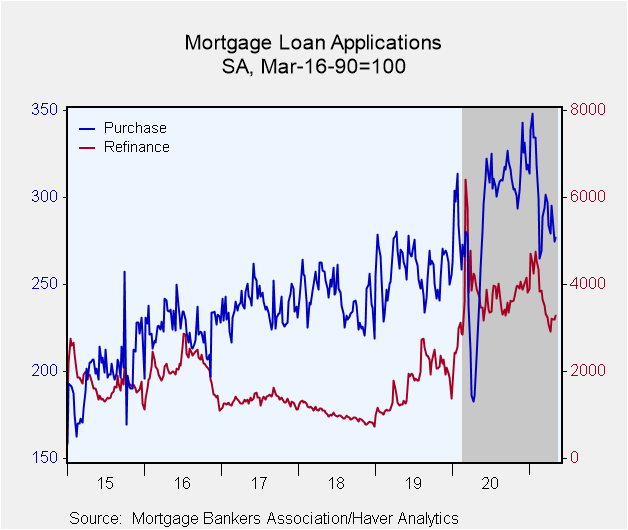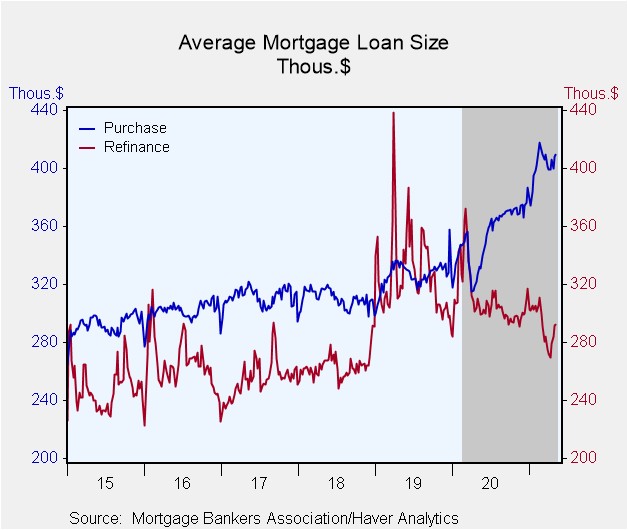 Global| May 12 2021
Global| May 12 2021U.S. Mortgage Applications Rise
by:Sandy Batten
|in:Economy in Brief
Summary
• Only the second increase in the past ten weeks. • Increase led by rise in applications for refinancing; applications to purchase posted only a small gain. • Mortgage interest rates fell. The Mortgage Bankers Association Mortgage [...]
• Only the second increase in the past ten weeks.
• Increase led by rise in applications for refinancing; applications to purchase posted only a small gain.
• Mortgage interest rates fell.
The Mortgage Bankers Association Mortgage Loan Applications Index increased 2.1% w/w (-4.2% y/y) in the week ended May 7, following a 0.9% decline in the previous week. This was only the second weekly increase in the past ten weeks. Applications to purchase a home edged up 0.8% w/w (13.7% y/y) versus a 2.5% decline in the previous week, and applications for refinancing jumped up 2.9% w/w (-11.5% y/y) after a 0.1% increase in the previous week.
The refinance share of mortgage activity edged up to 61.3% of total applications in the week ended May 7, its highest level since mid-March, from 61.0% in the previous week. The adjustable rate mortgage (ARM) share of activity slipped to 3.8% last week from 3.9% the previous week but remained well above its January 8 low of 1.6%.
Mortgage interest rates fell across the board last week. The effective interest rate on a 30-year mortgage declined seven basis points to 3.21%, its fifth decline in the past seven weeks but still above its 2.95% low reached in December. The effective 15-year rate fell six basis points to 2.56%, its fifth consecutive weekly decline. The effective rate for a 30-year Jumbo mortgage edged down two basis points to 3.37%. The rate on a five-year ARM plunged 19 basis points to 2.65%, its lowest level since April 2013.
The average mortgage loan size increased 0.2% w/w to $337,700 in the May 7 week, up from $337,000 the prior week. The average size of a loan to purchase a house rose 0.4% to $409,800. The average size of a refinance loan increased 0.3% to $292,300.
Applications for fixed-rate loans rose 2.2% (-5.1%y/y), only their second weekly increase in the past ten weeks. Applications for adjustable-rate mortgages increased 1.1% w/w (27.8% y/y) on top of 9.4% gain in the previous week.
This survey covers over 75% of all U.S. retail residential mortgage applications and has been conducted weekly since 1990. Respondents include mortgage bankers, commercial banks and thrifts. The base period and value for all indexes is March 16, 1990=100. The figures for weekly mortgage applications and interest rates are available in Haver's SURVEYW database.
| MBA Mortgage Applications (%, SA) | 05/07/21 | 04/30/21 | 04/23/21 | Y/Y | 2020 | 2019 | 2018 |
|---|---|---|---|---|---|---|---|
| Total Market Index | 2.1 | -0.9 | -2.5 | -4.2 | 63.0 | 32.4 | -10.4 |
| Purchase | 0.8 | -2.5 | -4.8 | 13.7 | 11.4 | 6.6 | 2.1 |
| Refinancing | 2.9 | 0.1 | -1.1 | -11.5 | 111.0 | 71.1 | -24.3 |
| 30-Year Effective Mortgage Interest Rate (%) | 3.21 | 3.28 | 3.26 | 3.50
(May '20) |
3.40 | 4.34 | 4.94 |
Sandy Batten
AuthorMore in Author Profile »Sandy Batten has more than 30 years of experience analyzing industrial economies and financial markets and a wide range of experience across the financial services sector, government, and academia. Before joining Haver Analytics, Sandy was a Vice President and Senior Economist at Citibank; Senior Credit Market Analyst at CDC Investment Management, Managing Director at Bear Stearns, and Executive Director at JPMorgan. In 2008, Sandy was named the most accurate US forecaster by the National Association for Business Economics. He is a member of the New York Forecasters Club, NABE, and the American Economic Association. Prior to his time in the financial services sector, Sandy was a Research Officer at the Federal Reserve Bank of St. Louis, Senior Staff Economist on the President’s Council of Economic Advisors, Deputy Assistant Secretary for Economic Policy at the US Treasury, and Economist at the International Monetary Fund. Sandy has taught economics at St. Louis University, Denison University, and Muskingun College. He has published numerous peer-reviewed articles in a wide range of academic publications. He has a B.A. in economics from the University of Richmond and a M.A. and Ph.D. in economics from The Ohio State University.










